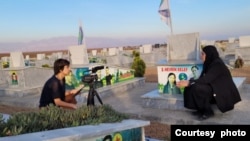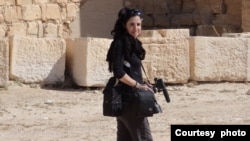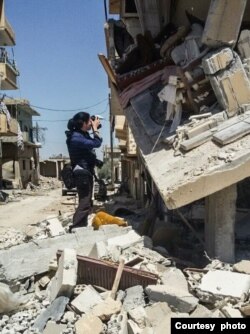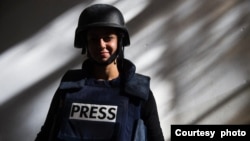Natalia Sancha has always adopted a collaborative approach to journalism. When out on assignment, she speaks to others covering the same story about their perspectives.
This partly stems from an interest in telling underreported stories, but as a female journalist in a male-dominated region, she says collaboration and supporting the women she works with have always been important.
“I would talk to male and female journalists, and I always realized that women had a similar perspective, because we had similar experiences while covering the story,” the 42-year-old journalist said.
That collaborative approach came into play in 2020 when a publisher asked Sancha if she was interested in writing a book about Syria.
She countered with a better offer.
“I told him that a collective narrative by women journalists about the broader region would have a different effect,” she said. “I could have written the book myself, but it would not have the same sense.”
Originally from Andalusia in southern Spain, Sancha spent the past 14 years in the Middle East covering conflicts in Iraq, Syria and Yemen, and reporting from Egypt, Lebanon and Tunisia.
She has been working more recently with the European Union communications department, after leaving Beirut for health reasons following a mass explosion that rocked the city in 2020.
Women “have a different experience because we would go to places that our male colleagues were not used to. Not because we're smarter, but just because the majority of the region is still Arab, Muslim and gender-segregated,” Sancha told VOA.
Having women reporters has an impact, she noted.
“If I put myself in the position of the reader, I would prefer to have a woman telling me the story because it is going to be about 100 percent of the population, which means you are going to have a more inclusive narrative on the conflict.”
For her book, Sancha reached out to other women who cover the Middle East, to ensure diverse perspectives from foreign and local reporters.
The result of the nearly two-year collaboration is Bullets for All, released in Spanish in April.
In the book, “we tell one story with different voices that represent all the women” from the region, Sancha said.
Each offers a personal perspective on covering historic moments, including the collapse of autocratic governments, popular protest movements and war. It also examines the discrimination and harassment women face in the newsroom and on assignment.
Making connections
Understanding language and culture goes a long way toward making progress in the region, says Maya Gebeily. The Reuters bureau chief for Lebanon, Syria and Jordan is one of the contributors to the book.
“There's a lot to say and show from the perspective of women reporters who were also then influenced by the women that they met as they were doing their reporting,” she said.
Born in the U.S. to Lebanese parents, Gebeily started her journalism career in 2013 with a local news site in Beirut, Lebanon. She went on to cover the region for Agence France-Presse before joining Reuters.
Gebeily said her American and Lebanese background helped her understand the region better, which in turn has shaped her reporting. Knowing the local language is an important part of that.
“When interviewing a minister or a displaced person or an activist, the most important element is getting their trust,” she said. “If you're able to speak the language and make them feel comfortable from the beginning, it changes everything. It grants you a very beautiful kind of access.”
In addition to Iraq and Lebanon, Gebeily, 30, has also traveled to Syria to cover the war against the Islamic State (IS) militant group.
“I’ve been very privileged to access some communities directly without having to work with a translator or a fixer, which also shapes the way that the stories come out,” she said.
Syrian-Kurdish journalist Khabat Abbas, who has covered the war in Syria, attests to the importance of that.
“It’s knowing the language and the culture that gives people a sense of comfort to open up to you,” she told VOA from Qamishli, Syria.
That knowledge helped when Abbas, 34, was on assignment with Sancha in March 2021. They traveled to a Kurdish-run detention camp in northeast Syria and interviewed female jihadists affiliated with IS, for a story in El Pais.
“While in Qamishli [in northeast Syria], I ran into two British journalists, very good colleagues of mine, who were disappointed after Shamima Begum and other women at the camp refused to talk to them,” Sancha said, referring to a young woman who left her home in Britain aged 15 to join IS.
“Their fixer was a man, so the jihadist women didn’t talk to them because they are radical, and they don’t talk to men. But then I was able to sit with Shamima and other women, who gave fantastic interviews from inside their tents,” Sancha said.
Abbas had a role in getting to talk to those women, she added.
Unlike Sancha and Gebeily, Abbas grew up in the marginalized Kurdish region of Syria, where until the war began in 2011, journalism effectively didn’t exist.
“Ordinary people in our region were used to seeing women pick up arms and fight, but they weren’t used to seeing a woman hold a camera on the streets and on front lines,” Abbas said. “It took a lot of sacrificing for me to convince my family and society that I’m as good, if not better, as my male colleagues.”
Journalism appealed to her because the story of the Middle East has often been told by male journalists, both local and foreign.
“The narrative hasn’t changed because of that, but if local and international women journalists get a real chance to tell the story of the Middle East, that narrative could change, which would affect the way others see this region,” Abbas said.
Sancha also believes women in journalism have an impact on the way issues are viewed in the region, including post-traumatic stress disorder and the effect it has on female health, and subjects such as violence and alcohol.
“We talk about all these issues that men normally wouldn’t not speak about,” she said.










